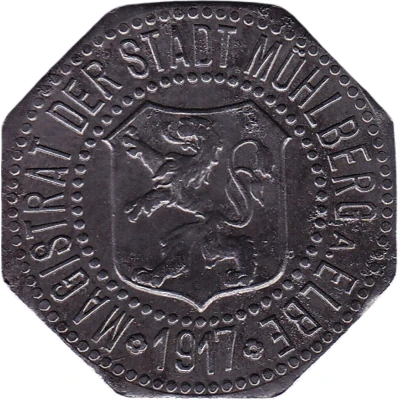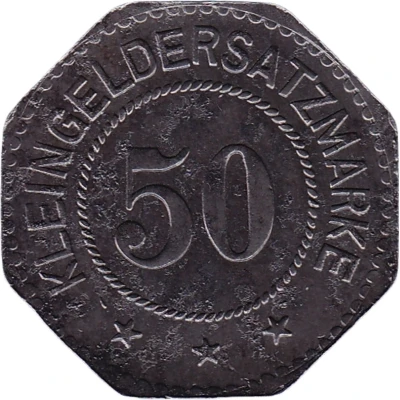


© gyoschak (CC BY-NC-SA)
50 Pfennigs - Mühlberg a. E.
1917 year| Iron | 3.5 g | 24.0 mm |
| Issuer | City of Mühlberg an der Elbe (Prussian province of Saxony) |
|---|---|
| Emperor | William II (Wilhelm II) (1888-1918) |
| Type | Standard circulation coin |
| Year | 1917 |
| Value | 50 Pfennigs (50 Pfennige) (0.50) |
| Currency | Mark (1914-1924) |
| Composition | Iron |
| Weight | 3.5 g |
| Diameter | 24.0 mm |
| Thickness | 1.15 mm |
| Shape | Octagonal (8-sided) |
| Technique | Milled |
| Orientation | Medal alignment ↑↑ |
| Demonetized | Yes |
| Updated | 2024-10-04 |
| Numista | N#390144 |
|---|---|
| Rarity index | 94% |
Reverse
Pearl rim, legend surrounding rope circle with denomination centered
Script: Latin
Lettering:
KLEINGELDERSATZMARKE
50
★ ★ ★
Edge
Plain
Interesting fact
One interesting fact about the 50 Pfennigs - Mühlberg a. E. 1917 coin is that it was issued during a time of economic turmoil in Germany, specifically during the hyperinflation period of the early 1920s. The coin's iron composition was a result of the wartime economy and the lack of available metals, and it was one of the few coins that were produced during this time that did not have a portrait of a king or emperor on it. Instead, it featured the image of a woman, allegedly a local resident, on the obverse side. This coin is a unique piece of history that reflects the economic and political climate of Germany during that time.